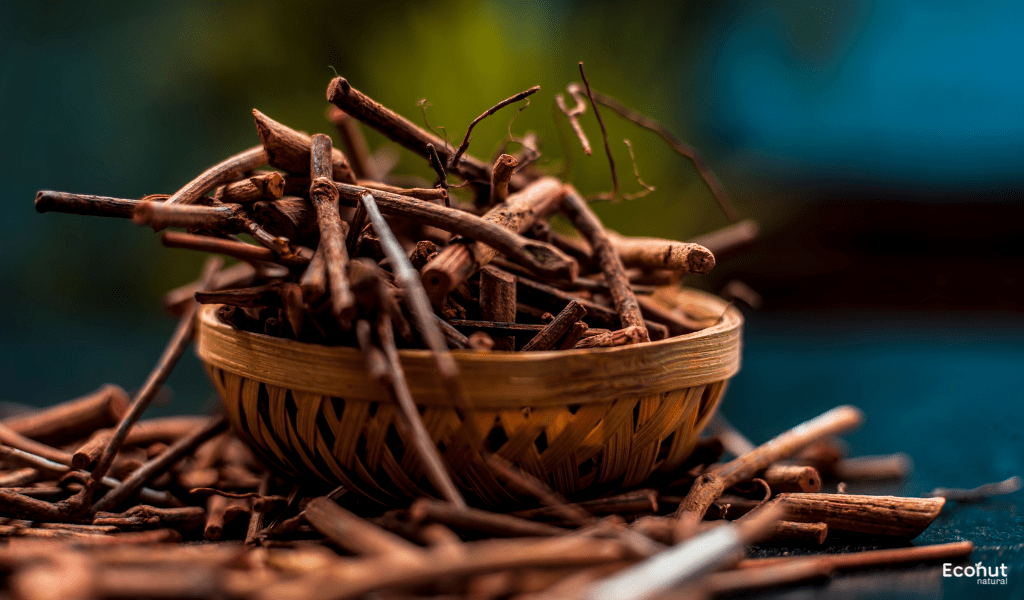Manjistha (Rubia cordifolia) is a red rhizomatous base and roots herb that climbs. Its maximum growth is 150 cm, or 1.5 m. The stem has four angles and is thin. It’s rough, evergreen leaves are oval to heart-shaped, with a long leaf stalk, and they are grouped in whorls of four per node, around the main stem in groups of four to seven.
One of the most precious herbs utilized in Ayurveda is manjistha. Because it contains an artificial coloring component, it was used to dye clothing in the past. Its therapeutic applications are also highlighted in Ayurveda.
Description
In Sanskrit, the term “Manjistha” itself means “bright red,” referring to the plant’s scarlet roots and its profound connection to the circulatory system. Manjistha’s capacity to balance and calm the Pitta and Kapha doshas contributes to the maintenance of a healthy cardiovascular system.
Botanical Name:
Rubia cordifolia
Family:
Rubiaceae
Leaves:
The evergreen leaves are typically oval or lanceolate, measuring 1-4 cm in length and 0.5-1.5 cm in width.
Flowers:
Its fruits are globose, dark purple or black, while its blooms are tiny, white or greenish.
Stems:
The base of stems is rough, woody, and lengthy. Traditional medicine has made use of the therapeutic properties of rubia cordifolia.
Roots:
The roots of the Manjistha plant are the most often utilized part of it. Their thin, reddish-brown bark covers their long, cylindrical form. Alizarin, a red dye that has been used for ages to color fabrics, comes from the roots.
Fruits:
The tiny, 4-6 mm diameter, reddish-black berries that are the fruits of the Manjistha plant usually, they are not utilized for medical purposes.
Habitat:
A well-known medicinal herb, manjistha is primarily found in Southeast Asia, Africa, and India.
Parts Used:
- Roots
- Stem
Dosage:
- Powder – 1-3 gm
- Decoction – 20-50 ml
Common name
Indian Madder, Madderwort
Chemical Constituents
Glycosides, saponins, anthraquinones, tannins, hexapeptides, quinones, and triterpenoids have all been found in manjistha. R. cordifolia is a significant medicinal plant that is frequently used to treat a variety of illnesses in the traditional medical system.
Synonyms
Vastrabhushana, Raktanga, amanga, Kalameshi, Vikasa,Lata, Yojanavalli, Bhandiri, Jingi, and Lohitalata
Other Language Names of Manjistha(Rubia cordifolia)
Hindi name – Manjeeth
Tamil name – Manjitti
Bengali name – Manjishta
Sanskrit name – Vikasa, Yojanavalli, Jingi, Samanga, Kalameshi, Lata, Lohitalata, Bhandiri, Raktanga, Vastrabhushana,
Malayalam name – Manjetti
Arabian name – Phuvva
Telugu name – Tamravalli
Farsi name – Runas
Kannada name – Raktamanjishte
Scientific Classification
| Kingdom | Plantae |
| Order | Genitanales |
| Family | Rubiaceae |
| Genus | Rubia |
| Species | R. cordifolia |
Ayurvedic Properties
Hindi/Sanskrit
- Rasa -Tikta, Kashaya, Madhura
- Guna -Guru, Rooksha
- Virya -Ushna
- Vipaka -Katu
English
- Taste -Bitter, Astringent, Sweet
- Physical Property-Heavy, Dry
- Potency- Hot
- Metabolic Property (After Digestion)-Pungent
Manjistha (Rubia cordifolia) Uses
- Natural color derived from manjistha roots is utilized in cosmetics and cosmetic items. It is an active component in blushes, lip balms, and other natural beauty products.
- In the textile industry, rubia cordifolia has been used to make fabrics and textiles. Indian cotton and chintz are known for their renowned red color, which is attributed to the principal dye molecule munjistin. The cloth has a hint of yellow and brown color due to the presence of alizarin and purpurin.
- The vivid red pigment that comes from Manjistha roots was used by artists, painters, and craftspeople in their dyes, paintings, and other artistic creations.
Manjistha (Rubia cordifolia) Benefits
Blood purifier:
The purifying of blood is the main purpose of the herb manjistha. Clean blood is essential for healthy skin and hair. Manjistha (Rubia cordifolia)is a powerful cleanser of blood. It purges the blood of all impurities and cleanses it. Manjistha efficiently treats skin disease symptoms. It also raises immunity levels.
Treats Diarrhoea:
Manjistha’s strong antibacterial and anti-diarrheal qualities are widely utilized to eradicate germs from the intestines that cause intestinal infections and diarrhoea. When consumed in prescribed dosages, it can be used to treat AMA ATISARA, or acute diarrhea in which the bowel is slimy, sticky, mucus-filled, and foul-smelling. This concoction cures dysentery and successfully lowers the frequency of feces in addition to eliminating toxins from the body.
Diabetes:
Manjistha roots are used in a variety of therapeutic compositions by Ayurvedic sages. Manjsitha’s spicy and bitter flavor maximizes insulin levels, speed up the metabolism, and eliminate waste. Antioxidant and hypoglycemic qualities also help to reduce blood sugar and allay its consequences.
Natural Skin Detoxifier:
Manjistha has strong detoxifying properties that help remove impurities from the skin. It helps to create a more radiant and healthy complexion by purifying the blood and ensuring that the skin gets the vital nutrients and oxygen it needs.
Mental Health:
Manjistha has strong detoxifying properties that help remove impurities from the skin. It helps to create a more radiant and healthy complexion by purifying the blood and ensuring that the skin gets the vital nutrients and oxygen it needs.
Also Read: Haritaki / Harad (Terminalia chebula) – Uses, Dosage, Benefits & Side Effects
Manjistha (Rubia cordifolia) Side Effects
Cancer:
Manjistha may have mutagenic qualities, which means it may harm DNA and raise the risk of cancer, according to some research.
Pregnancy:
Pregnant women should abstain from manjistha due to the potential for birth abnormalities caused by its ingredients.
Digestive issues:
Some people may get constipation after taking manjistha. Before using Manjistha, it is best to consult a healthcare provider if you have any stomach issues.
Conclusion
Manjistha is an amazing herb with great regenerative qualities that purifies blood. It is widely used for treating a wide range of skin conditions, improving lymphatic functions, treating flu and feverish conditions, relieving liver problems, managing cough and cold, sore throat, treating respiratory diseases, preventing viral infections, promoting digestion, and many other conditions because of the goodness of the essential bio-active ingredients and the quarry of therapeutic properties.
FAQS
Is Manjistha Able to Handle Diabetes?
Tikta Rasa of Manjistha and its potent hypoglycemic effect rapidly assist in lowering blood glucose levels. Because of its antioxidant properties, it effectively lowers the risk of complications from diabetes.
What is Manjistha used for?
Manjistha has long been used to treat animal wounds, intestinal worms, diarrhea, liver fluke, and maggots. Blood purification is a popular application for manjistha. Numerous more medicinal benefits include calcium channel blocking, anti-diabetic, anti-stress, and anti-platelet effects.
What are the side effects of Manjistha?
Manjistha overdose can cause the color of the urine and feces to turn orange or brown. Because Manjistha also possesses anti-platelet properties, people who are already taking anticoagulant drugs should exercise caution when using this herb.

